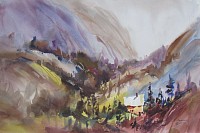BIOGRAPHY

Wes Hanson
Wes Hanson's watercolors are characterized by a luminous quality and a remarkable sensitivity to light and atmosphere. He masterfully captures the essence of the Coeur d'Alene landscape, often focusing on its interplay of water, sky, and land. His style is impressionistic, employing loose brushstrokes and transparent washes to create a sense of fluidity and movement. The colors are often subtly modulated, evoking a sense of tranquility and serenity. While his paintings capture recognizable scenes, there’s a distinct impressionistic freedom that emphasizes mood and atmosphere over strict realism. Details are suggested rather than meticulously rendered, allowing the viewer's eye to participate in completing the image. Hanson's watercolors possess a delicate balance between representation and abstraction, a hallmark of his unique approach to depicting the beauty of the Coeur d’Alene region.
Bio
Wes Hanson is attracted to natural landscapes because they provide compelling painting subjects and offer a respite from the fast-paced world. He draws and paints them using watercolors and acrylics.
He has studied landscape painting with Stephen Quiller, Irving Shapiro, Zoltan Szabo, and Milford Zornes.
He teaches drawing and painting to adults for Spokane Art Supply, the Coeur d’Alene Kroc Center and the Artisan Barn in Uniontown, Washington.
His paintings have been displayed at the Entree Gallery at Priest Lake, the Denise Oliver Gallery in Harrison, Idaho, and the Artisan Barn in Uniontown, Washington. He has demonstrated products for the Jack Richeson Company, a major art material supplier.
Wes Hanson lives on a farm south of Coeur d’Alene. The farm has been in the family since 1902 and is permanently preserved through a conservation easement. He taught at the high school level for thirty years.
Artist Statement
“Landscape paintings, like nature, present scenes that are both real and mystical and encourage viewers to explore and wonder. Well done paintings allow people to see commonplace things in new ways. Each successful painting presents a clear vision of a subject. When that vision is put on paper, it becomes a strong design. The painter’s use of dark and light values and colors brings subjects to life. Each landscape challenges the artist to simplify and dramatize it. Painting is an engaging and enjoyable creative process.”
